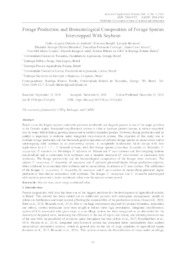Forage production and bromatological composition of forage species intercropped with soybean.
Forage production and bromatological composition of forage species intercropped with soybean.
Resumo: Brazil is one the largest soybean and cattle producer worldwide and degrade pasture is one of the major problem in the Cerrado region. Integrated crop-livestock system is a key to increase grower income, to reduce crop yield loss by water deficit during growing season and to reclaim degraded pasture. However, forage production and its quality is important to evaluate under integrated crop-livestock system. The objective of this study was to evaluate forage production and the bromatological composition of different forage species in monoculture and in intercropping with soybean in an oversowing system. A completely randomized block design with four replications in a 5 × 2 + 1 factorial scheme, with five forage species (Urochloa brizantha cv. Marandu; U. ruziziensis; P. maximus cv. Mombaça; P. infestans cv. Massai and P. americanum) and two cropping systems (monoculture and a consortium with soybeans) and a standard treatment (P. americanum in succession with soybeans). The forage productivity and the bromatological composition of the forages were evaluated. The species U. ruziziensis, U. brizantha, M. maximum and P. infestans presented higher forage production capacity, when cultivated in consortium with soybeans and in monoculture, in relation to P. americanum. The cultivation of the forages U. ruziziensis, U. brizantha, M. maximum and P. americanum in monoculture produced higher productivity than that in consortium with soybeans. The forages U. ruziziensis and U. brizantha intercropped with soybean presented a better nutritional value over the autumn-winter period.
Ano de publicação: 2020
Tipo de publicação: Artigo de periódico
Unidade: Embrapa Milho e Sorgo
Observações
1 - Por padrão são exibidas publicações dos últimos 20 anos. Para encontrar publicações mais antigas, configure o filtro ano de publicação, colocando o ano a partir do qual você deseja encontrar publicações. O filtro está na coluna da esquerda na busca acima.
2 - Para ler algumas publicações da Embrapa (apenas as que estão em formato ePub), é necessário ter, no celular ou computador, um desses softwares gratuitos. Sistemas Android: Google Play Livros; IOS: iBooks; Windows e Linux: software Calibre.
Acesse outras publicações
Acesse a Base de Dados da Pesquisa Agropecuária (BDPA) para consultar o acervo completo das bibliotecas da Embrapa.

